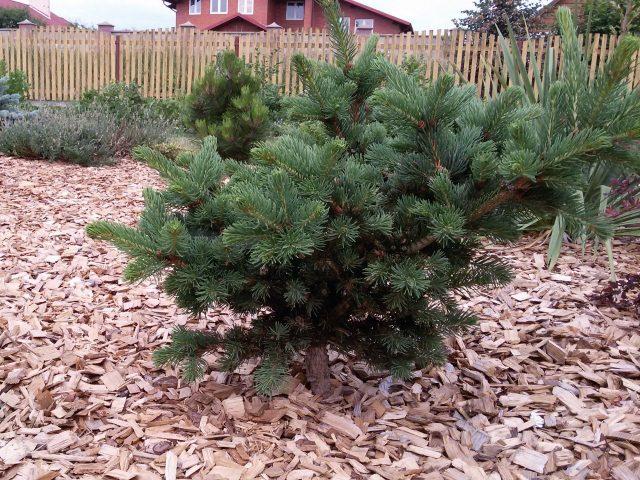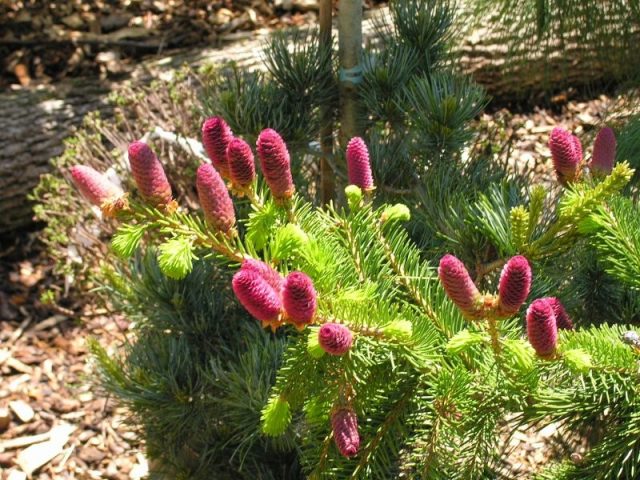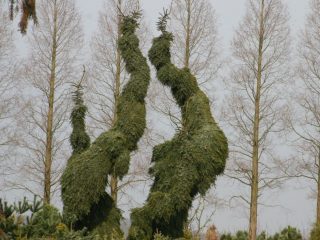Content
Spruce Lucky Strike is an evergreen original coniferous plant that fits perfectly into the landscape. It is very popular among gardeners; they love it for its compact fluffy crown and numerous bright cones. This ornamental crop is considered undemanding to grow and is suitable for planting in small areas. Knowing all the nuances of Lucky Strike agricultural technology, as well as following the recommendations for caring for it, you can add zest to any place in the garden.

Translated, Lucky Strike sounds like “lucky shot”
History of origin
Lucky Strike was bred by breeders from Holland in 1983. They obtained it thanks to biological material taken from the Colorado spruce, discovered in the western part of the United States. Starting from the 1985s, the plant began to actively spread, it began to be grown in European countries, and now spruce is in high demand among Russian agronomists.
Description of prickly spruce Lucky Strike
Prickly spruce picea pungens Lucky Strike is a typical representative of the Pine family, with an individual feature, which lies in the original appearance of the evergreen crown. The tree has an asymmetrical, irregular and slightly disheveled shape.
Spruce needles are prickly, short (2-3 cm in length), hard and thick. Its color is dark green with a barely noticeable bluish tint. Young needles are yellow-green and not particularly prickly. The beautiful image of the spruce tree is given by the cones that are distributed along all the short branches sticking out in different directions. They are quite large and long, up to 10 cm, and some specimens can grow up to 15 cm. They predominate on the tree in large numbers and remain on the branches until the next season. While the cones are young, their color is reddish or purple, eventually turning brown. The trunk of Lucky Strike is smooth, not particularly thick, the bark is brownish-yellow in color. The root system is superficial.

The tree owes its special decorativeness to its cones, reminiscent of burning candles.
Dimensions of spruce Lucky Strike
Lucky Strike is a low-growing variety that has a dwarf appearance even at an advanced age. Tree growth is slow, no more than 15 cm in 12 months. The spruce is compact, small in height, rarely growing up to two meters. A ten-year-old tree has an average size of about 120 cm, older specimens are 130-150 cm. The crown width of Lucky Strike is also not particularly large, until it reaches the age of ten years it is approximately 20-40 cm, the maximum diameter of an adult plant is one and a half meters.
Frost resistance
Lucky Strike has good cold resistance and tolerates winter well even at low temperatures (down to -39 °C). But in harsh conditions it needs to be covered with spruce branches.
In addition, spruce is able to grow even in unfavorable conditions, for example, near industrial sites and on the polluted streets of megacities. It tolerates heat and short-term drought with ease.
Advantages and disadvantages
Despite all its unpretentiousness, in addition to its advantages, Lucky Strike also has disadvantages, which you can learn about below.

Lucky Strike will look elegant only in a sunny area
Advantages:
- beautiful and unusual appearance;
- compact dimensions;
- ease of care;
- strong immunity;
- cold resistance.
Flaws:
- prickly needles that complicate the care procedure;
- long growth;
- high price of seedlings.
How to plant correctly
Lucky Strike should be planted in well-lit flower beds with sandy or sandy loam soil. If the soil is heavy, then you should definitely take care of drainage; add humus or compost to poor soil.
The Lucky Strike landing pattern is as follows:
- Two weeks before work, dig a hole so that its size is twice the size of the plant’s root system.
- Humus and peat are added to the soil from the hole and, if necessary, loosened with sand.
- Before planting Lucky Strike, part of the prepared soil mixture is placed at the bottom of the hole, then a layer of broken brick is laid and soil is added again.
- Water the hole well and wait until all the water goes into the ground.
- The spruce is planted so that the root collar is at ground level, covered with the remaining soil and watered again (at least five buckets of water per plant).
- The tree trunk circle is mulched.

Choosing a good site for Lucky Strike is the key to its successful cultivation
Features of care
Lucky Strike is unpretentious and can withstand difficult climatic conditions, but if you make mistakes while caring for it, they will negatively affect the appearance of the crop. The technology for growing a tree is simple and consists of the following procedures:
- Watering. Young Lucky Strike is moistened abundantly as the soil dries. Even a small tree needs 10 liters of water at a time. At the same time, for several months after planting, it is advisable to add Kornevin to the liquid.
- Loosening. At the initial stage of growth, it is important to constantly remove weeds around the seedling, carry out shallow loosening and mulching with wood chips or dry bark. In autumn, use peat as mulch.
- Fertilizer. Lucky Strike is fertilized in the spring with complex formulations intended for coniferous species. Also for this purpose, use 100 g of nitroammophoska, diluted in a bucket of water. Organic matter cannot be added, as it will impair the winter hardiness of the tree.
- Trimming. The tree practically does not need to remove branches. Until the age of ten, you only need to trim dry and damaged branches, after which you need to shorten young shoots. The procedure should be carried out at the beginning of summer after the end of sap flow.
- Preparing for winter.To protect young spruce trees from frost in late autumn, gardeners cover them with spruce branches, and to prevent the branches from breaking under the snow, they are lifted and tied up.
Don’t forget to regularly inspect plants for diseases and pests, and take measures to eliminate them at the first sign.
Reproduction
It is most advisable to plant Lucky Strike spruce with seedlings purchased in a specialized store. In this case, the plant will already have a developed root system, which guarantees a pure variety.
If you want to propagate spruce yourself, you usually use the seed method. To do this, at the end of autumn, remove the cone from the tree, dry it well, remove the seedlings from it and soak them. Then they sow in large containers, constantly monitoring the soil moisture, while providing optimal conditions for the sprouts.
Less often, gardeners propagate the crop with cones. To do this, in the spring they are buried in the ground to a depth of 7 cm, and in the fall young shoots appear from them.
Diseases and pests
If you follow the recommended rules of agricultural technology while growing Lucky Strike, then diseases or pests can attack it only under unfavorable weather conditions. Usually this is almost immediately noticeable by thin, dull needles and gradually drying branches. As a rule, the cause of this is a fungal infection (Schütte).
Among insects, spruce can be of interest to the caterpillars of the pine beetle moth and the spruce-leaf hermes.
Spruce Lucky Strike in landscape design
Lucky Strike is a universal plant for decorating a site, and it can be planted in different places. It can act as a hedge, become a decoration for the area behind the fence, or disguise unsightly buildings with its attractive appearance. Thanks to spruce plantings, you can zone several areas in the garden.
The culture looks great in landscape compositions; when grown in a pot, it will become an original decoration for a gazebo or terrace. It can be planted in a flowerbed near single plants and group plantings. Lucky Strike will successfully harmonize with deciduous and coniferous trees and shrubs, and will complement the stone garden with its brightness.

Due to its small size, the variety can be grown in wide flowerpots
Conclusion
Spruce Lucky Strike is a decorative variety that will become an original decoration for landscape design made in any style. Of all the variety of varieties, this one deserves special attention from gardeners. The tree has a magnificent and quite original appearance, is easy to grow, and thanks to its compact size and low growth, it can be planted in any area of the site.
Reviews of prickly spruce Lucky Strike








